Downsizing leads GMC across new Terrain
By John Gilbert
It has always seemed as though vehicles with “GMC” logos on their grilles have gotten the short end of the promotional emphasis from General Motors, which seems to emphasize Chevrolet on about a 50-to-1 ratio in their advertising. But when you start evaluating the 2018 models, those GMC models are proving capable of standing by themselves.
It’s certainly a lot simpler to promote a big pickup truck, the Sierra, and a midsize pickup, the Canyon, and then line up your three GMC SUVs: the giant Yukon, the midsize Acadia, and the Terrain. The Yukon, of course, runs and is equipped parallel to Chevy’s Suburban and Tahoe, while the Acadia is paralleled by the Chevy Traverse.
The Terrain, meanwhile, has been made more compact and runs alongside Chevy’s Equinox. They are more compact than the midsizers, but that gives them a couple of very large advantages. For one, they are lighter and feel quicker than their more ponderous brethren farther up the size scale, and second, they don’t need the giant 6.2-liter V8 or even the 3.6-liter V6 to get around with quick agility in virtually every circumstance.
But it’s right about there that GM has allowed a split of the otherwise twin-running vehicles. True, they are still competitors for each other, but you can get the Equinox for somewhere between $24,500 and $35,000, and it has been entirely redone for 2018 and looks better than it ever has. The GMC Terrain also has been entirely redesigned, and its price ranges from a base $26,000 to a smidge over $40,000. The difference may be close to imperceptible, but I figure it goes for a few more luxury touches, and more sound-deadening in the GMC, which stands about one rung higher on the stepladder of GM SUVs. The Terrain seemed quieter than the Equinox I recently had driven, but that could be sound-deadening, or even a difference in tires.
I enjoyed my week-long test drive with the Terrain, which came at a time when I was required to make a couple runs from Duluth to Saint Paul for a hockey tournament. Any vehicle could breeze through that 400-mile round trip without breathing hard, but this particular week was one of those when Spring was engaged in mortal combat with Winter, and we were as likely to see sunshine and blue skies, or grey clouds and a snowstorm. Or maybe both, in the same day.
So having the GMC Terrain with its all-wheel drive was a nice comforting thought, knowing I wouldn’t get back home until 1 a.m. or so. Curiously, the Terrain’s all-wheel-drive system can be controlled by a knob on the console, rather than being the trendy automatic system so popular these days. Personally, I prefer having the right to make that adjustment myself, because you can improve fuel economy by a couple mpg-s if you are in front-wheel drive. I did, however, make sure to remind my wife, Joan, who is an excellent driver but needed to know that if you’re headed for a snow-covered hillside or it starts snowing, make sure to click into AWD.
The Terrain (and the Equinox) actually are smaller than they used to be, another refreshing twist by GM, which tended to always go bigger when given the option. With the runaway popularity of the SUV segment, GM is maneuvering to make sure they are competing in all the niches.
By making it smaller, the GMC Terrain has a base engine that measures only 1.5 liters, with a turbo bringing it up to adequate. My test vehicle had the optional 2.0-liter 4, also turbocharged, with 252 horsepower and 260 foot-pounds of torque. That’s more torque than the newly available 1.6-liter tiurbo-diesel by 10.
That made an interesting aside for my test-driving. The comfort and the neat driving and occupant features were all duly noted, and the numerous safety stuff, including a larger 8-inch touchscreen at the top of the center stack, and a new 360-degree camera that gives a top-down view of anything and everything around your Terrain. Then there’s the center console, cavernous in its capacity. It also has lane-keep assist, which some critics hate, but merely keeps you more advised on how you’re driving.
But the small engine made me always aware of how efficiently I could take off when pulling onto a freeway or highway, and it never faltered. That left the other key element to me, which was fuel economy.
The turbo adds power, and the 9-speed automatic worked well, so I had no trouble holding it at freeway maximums of 70 or so. I also anticipated that a long drive with the cruise at 70 would assure me of very strong fuel economy. I was wrong. I averaged between 24.8 and 25 miles per gallon, highway or city, AWD or FWD.
Now, we’re a spoiled lot here in the U.S., where as soon as gas prices drop, we all forget buying enery efficient cars and small SUVs and go after bigger, stronger, more powerful and less fuel-efficient vehicles. We’ve been riding a long crest of the gas price roller-coaster, and car dealers and salesmen will scoff at such nitpicking, but when gas prices start to rise, we know they can keep on a-rising.
Now the word comes that since our gas prices shot up by about a dime, then by another 15 cents, during the last two weeks of August, there’s a good chance they won’t be coming back. Summer, and a couple of major holidays, are on their way, so why would we expect fuel companies to drop their prices now?
In my usual grumbling about fuel economy, I always try to make the point that people really don’t seem to mind the rise and fall, once gas is less than $3 a gallon. But everyone who discusses it talks about the price of regular, without checking on the disparity between regular and premium. Used to be a nickel, then a dime, then it spread apart until now, when you might pay 30 or 50 cents a gallon more for premium.
If regular goes to $3.25, and you’re paying $3.70 a gallon because your car requires premium, or 91 octane, a tankful can be a pinch. It is a good reason to check when you’re buying a new vehicle and find out if it will run fine on regular. Over the course of five years, that could save you a lot of money.
Meanwhile, back to the advantages of the downsized Terrain, they come mostly in agility and the ease of handling in traffic, biut since GM is aiming the Terrain at top-selllng midsize SUVs like the Honda CR-V, Toyota RAV4, and Mazda CX-5 — all of which deliver over 30 mpg — then the Terrain should give me more than 25 mpg.
For those who don’t care about such trivia, the Terrain offers anybody who ever owned any GM SUV a lot to like. I think the new Equinox is much more attractive, and the Terrain is, as they say, industrial-strength handsome. The new grille might have started out trying to be a trapezoid, but with all four corners rounded elegantly, it makes a striking first impression. The silhouette also is dramatically more appealing, and my favorite view of the vehicle is the rear corner.
I didn’t realize that until the week following my test drive, when I was driving along on a short freeway stretch and spotted a very handsome car ahead and one lane over to my left. The way the side contours rose up slightly as they approach the rear, and almost meet the roofline caught my eye. I accelerated a bit so I could read the lettering on the rear: Terrain.
That says a lot. I spent so much of the week driving the Terrain I didn’t spend any of it outside it, where I could appreciate the redesign.


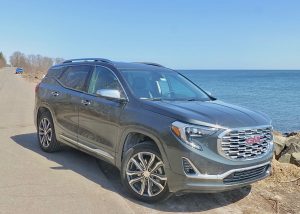
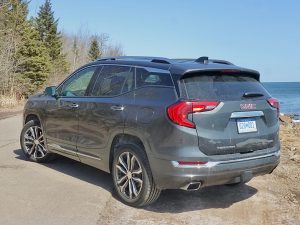
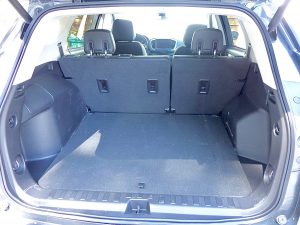
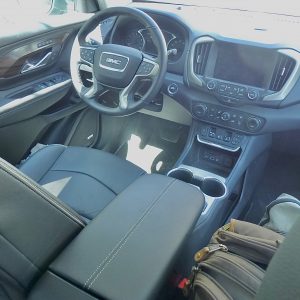
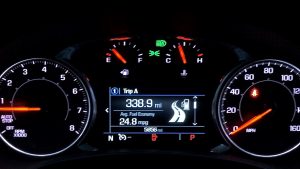
 John Gilbert is a lifetime Minnesotan and career journalist, specializing in cars and sports during and since spending 30 years at the Minneapolis Tribune, now the Star Tribune. More recently, he has continued translating the high-tech world of autos and sharing his passionate insights as a freelance writer/photographer/broadcaster. A member of the prestigious North American Car and Truck of the Year jury since 1993. John can be heard Monday-Friday from 9-11am on 610 KDAL(www.kdal610.com) on the "John Gilbert Show," and writes a column in the Duluth Reader.
John Gilbert is a lifetime Minnesotan and career journalist, specializing in cars and sports during and since spending 30 years at the Minneapolis Tribune, now the Star Tribune. More recently, he has continued translating the high-tech world of autos and sharing his passionate insights as a freelance writer/photographer/broadcaster. A member of the prestigious North American Car and Truck of the Year jury since 1993. John can be heard Monday-Friday from 9-11am on 610 KDAL(www.kdal610.com) on the "John Gilbert Show," and writes a column in the Duluth Reader.